April 2014 – Volume 16, Issue 4: The 6,000 Year Old Solar Industry
IN THIS ISSUE
Flanigan’s Eco-Logic
Ancient Solar
Solar Heat for Horticulture
Solar Water Heaters
Solar Building
Solar Motors
Early Photovoltaics
Niche PV Applications
The Modern Age of Photovoltaics
Conclusion

Flanigan’s Eco-Logic: The 6,000 Year Old Solar Industry
This is a special Edition of EcoNet News featuring a book titled “Let it Shine: The 6,000-year Story of Solar Energy.” I’d met its author at the Solar Decathlon in Irvine this past fall. He was introduced by a mutual friend, Tor Allen of the Solar Schoolhouse. A quick review of his testimonials – from Amory, Denis, Lester, and others I’ve had the privilege to know – warmed me quickly.
John Perlin has indeed brought a rich perspective to solar energy. I read every word and liberally underlined the text. That’s out of character for me. Let it Shine outstripped my expectations and I believe will be of great interest to many EcoNet readers. Check it out: the New World Library. It’s got a brilliant forward by Amory Lovins. Renewables at parity: a force, my words.
The pace of greening. For renewables, 2013 was another banner year. There is momentum. Do we really need to prolong a transition to a highly efficient and sustainable society? We think not. Amory Lovins writes in Let it Shine, “In 2013, renewable energy, once derided as a fringe activity, is quietly taking over the world market, driving by overwhelming civic demand and business logic.”
So what’s up with 6,000 years? Perlin begins with Early Use of the Sun, from Chinese solar architecture in 6000 BCE, then Ancient Greece in 500 BCE – 300 CE. (BCE, Before the Common Era, and CE, Common Era, are the non-Christian equivalents of BC and AD.) Burning mirrors caught my attention used from 400 BCE to the 1700s as commonly as matches and cigarette lighters. There was heat for horticulture, and solar hot boxes in the late 1700s and early 1800s. Harnessing the sun’s heat and energy has been a longstanding quest.
Perlin covers the fundamentals of solar architecture. Solar orientation is age-old because it makes sense. A best practice is for a home’s whose functionality – from morning breakfasts awash with sunlight to evening sunset dining – tracks the sun. And solar homes harness the sun’s energy in more ways than one. There’s a vast repertoire of language about how sunshine makes you feel better. For centuries the warmest rooms in the house were reserved for elders.
I knew nothing about the exciting and hopeful era of solar engines that were introduced in 1860. The first “practical” solar engine operated from 1906 – 1914. At the same time, other solar pioneers were working on providing domestic hot water. The first commercial solar water heaters were introduced in 1891 with the progressive “day and night” concept.
In the 1950s, the use of the sun to generate electricity took root. Let is Shine describes the history of photovoltaics and its early pioneers. Their experiments ushered in a whole new way of generating electricity. Perlin recants tales from the Bell Laboratories in Murray Hill, New Jersey in the 1950s where the first modern-day, silicon solar cells were developed for telecommunications. Their cost was $487/watt. Today, the price is less than a dollar!
The Sun in China, Ancient Greece and the Roman Empire
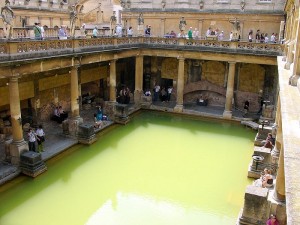
Solar heated Roman Baths
Chinese philosopher Yu Li compared a correctly built structure to a person who dresses appropriately according to changing seasons: “As it is true that clothing should be cool in the summer and warm in the winter, the same holds true for a house.” The Chinese then recognized the value of eaves that shade windows from hot summer suns, but that allow winter-time heating as the sun arcs low on the horizon and streams in under the eaves. Perlin writes of millennia-old solar techniques for building homes and palaces in China.
It was a ritual for the emperor to face south whenever in the company of an audience. Many of these Chinese well-designed homes had “the cozy corner,” heated by the sun’s rays. Elders “were often resided” in these southwestern corners of the home. The sun provided comfort, but even then a fundamental motivation for using the sun’s heat was to save money. Households were intent on avoiding the costs of charcoal that spiked in the coldest times of year.
In Ancient Greece, Socrates was reported to have stated to a disciple, “To put it succinctly, the house in which the owner can find a pleasant retreat in all seasons… is at once the most useful and the most beautiful.” Aristotle also weighed in on design, and particularly comfort in good design. The Greeks had self-help books on how to design solar homes.
Roman baths had large glass windows to trap heat called a heliocaminus; a solar furnace. The largest, the Baths of Caracalla, held two thousand people at a time. The heliocaminus was also popular in homes, covered with either glass or thin sheets of mica or selenite. In the days of Augustus, first century CE, solar architecture was so important that it provoked disputes over sun rights that required adjudication in the Roman courts.
Perlin presents the earliest planned communities. There’s Olynthus, the planned solar city just northeast of Athens in Greece. The date was 432 BCE. The North Hill section of the Olynthus planned community assured that every home would have good solar access. This was out of necessity. Olynthus is at the same latitude as New York City and had very limited access to fuel.
Solar Heat for Horticulture

Dutch Fruit Wall
Solar heat for horticulture dates back some 500 years. One early practice was the use of fruit walls that functioned by harnessing solar heat. The French would nail a tree to a south-facing wall that would capture, store and release solar heat, hastening the ripening process. Farms of sloping fruit walls in France in the 17th century faced the southern horizon at an angle chosen or optimum year-round solar heat collection.
Early cold frames date back hundreds of years, perhaps to the 1500s. The Duke of Rutland in England leaned glass up against walls to protect new seedlings. These encasements were effective in retaining heat and helping extend the growing seasons, allowing the British to grow more exotic plants.
Dutch greenhouses in 1550s are considered the first modern greenhouses. The Dutch used double-paned glass and canvas covers at night. New plate-glass manufacturing methods in the late 1600s accelerated the use of solar greenhouses, and allowed for larger windowpanes. Cold frames and glass greenhouses became immensely popular in England, Holland and across the continent. In parallel there was a rise of glass-covered conservatories in upper-class homes, later abandoned due to their inefficiency during the fuel rationing in World War 1.
Salt also relates to solar. Gandhi marched to the seashore, picked up the crust of salt, sprinkled it on his food, demonstrating the Indian right to harvest salt and what is there. Flemish salt manufacturers used the sun to evaporate water. “A great help for the sparing of firewood,” said the British who adopted the technique. The solar salt works of Syracuse, New York were the source for half of all the salt in America in 1850s. Solar production of salt saved the burning of hundreds of millions of tons of wood and coal.
Solar Water Heaters
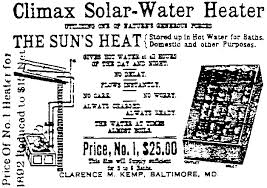
Climax Ad from 1891
I love John Perlin’s style. His historical review of bathing habits gave me a chuckle. It was the 19th century, he writes, that Americans and Europeans began to bathe on a regular basis. Heightened sense of personal hygiene was taking root. But heating water was laborious; that’s why you just took one bath a week. It was an ordeal heating large pots on stoves, then carrying heavy pales of steaming hot water to “bath room.” An important step was to attach hot water tanks to cook stoves.
The first solar water collectors were developed by farmers in the American Midwest. They painted metal tanks black, mounted them on rooftops, connected them to their water systems, and enjoyed hot showers after working the fields. The systems worked, but when they worked and for how long they provided hot water were other important questions. Without insulated storage these systems were of limited utility.
The first commercially available systems – the Climax solar water heater in 1891 – used tanks in glass-covered boxes that retained heat after sunset. In Maryland, the Climax produced hot water from April to October. In many parts of California, it produced free hot water year-round. By 1900, the Climax had sold 1,600 units. Then in 1909 came the “Day and Night” solar water heater which had two tanks, one for solar collection and the other insulated with powdered limestone for storage. The tanks were guaranteed not to lose more than a degree per hour. A later development was replacing the collector tanks with thin copper pipes which greatly increased absorption.
In January 1913, a freak cold spell hit Southern California and the solar water heating industry was badly hurt. Temperatures dropped as low as 10 degrees F. Collectors froze and copper pipes “popped like popcorn all over the county.” This led to the development of collector circulation systems that have heating loops filled with alcohol and distilled water to prevent freezing. Using heat exchangers in the form of coils, heat can be transferred from one medium to potable water.
With freezing addressed, the solar water heating business began to flourish again. Popular Mechanics ran a do-it-yourself article on building solar water heaters. It was in vogue and advertisements doled out the virtues of solar, reducing natural gas bills. In 1920, 1,000 people bought Day and Night solar systems. But between 1920 and 1930 huge amounts of natural gas was found in the Los Angeles basin, and prices plummeted, slashed by 75% for consumers. Wherever the gas mains went, consumers jumped on board, and interest in solar plummeted.
The action shifted to Florida where there was no natural gas and it’s difficult to lay pipes in subsurface marshland. Many bungalows in Miami began to have solar systems. The residential building boom there was a boom for solar. The Solar Water Heater Company was the dominant company, and given sloping roofs put tanks cut into roofs disguised as chimneys. An advertisement in 1941 spells out a no-money-down financing option and low monthly payments.
World War 2 dealt a blow to the U.S. solar water heating industry given a government freeze on non-military use of copper. Then older systems began to fail, typically at 2:00 in the morning when municipal water use is lowest and thus pressure is highest. Solar was also getting more costly, given higher copper prices and labor costs. Meanwhile, electric water heaters were getting less expensive. Florida Power and Light, for one, adjusted its rates to favor electric water heating, and even offered free installations of electric water heaters. By the late 1950s, no one was buying solar water heating in America.
Instead, the action shifted around the globe to areas where solar water heating makes most sense. It’s an appropriate technology for fuel-short regions like South Africa. In the 1950s, “vinyl air mattress” solar water heater was introduced by Sukeo Yamamoto in Japan. It was low cost and highly effective. Australia took a leadership role promoting solar water heating. Solar was also advancing in remote areas remote locations such as the Canary Islands.
Israel became and has remained a leader in solar thermal. Nearly 50,000 solar water heaters were sold in Israel from 1957 to 1967. Ironically, the victory in the Six Day War of June 1967 dealt a blow to solar when Israel captured large oil fields on the Sinai Peninsula ending decades of fuel scarcity.
Solar Building
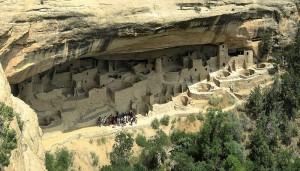
Anasazi Cliff Dwellings
In America, solar architecture began with indigenous peoples such as the Pueblos Indian tribes in the Southwest. The Anasazi built a number of large community structures that took advantage of the sun. Their south-facing cliff dwellings showed a remarkable sensitivity to solar design. As the country was pioneered and developed, basic solar orientation made sense, fending off the cold winds from the north. Many homes were built to face south, and were flanked by deciduous trees to capture the ideal blend of unobstructed light and heat gain in winter, and shade in summer.
But Perlin reports that in the mid and late 19th century, solar building became a lost art as five million people poured onto America’s shores, and mostly into cities like New York, Philadelphia, Boston, and Baltimore. Common-sense, solar designs were all but forgotten. Arbitrarily planned streets now made solar orientation difficult.
But in cases logic prevails. In this case the logic of solar power prevails. There was a “solar revival” in the 1930s for household design that captured the sun for heat and hot water. There was then and has continued to be considerable experimentation. MIT produced its first solar house in 1939, complete with a 17,400 gallon storage tank for radiant solar thermal floors. The house as collector concept took root using solar hot air systems, solar envelope design, and trombe walls. To this day, universities and research labs compete to build the most efficient homes, always tapping the power of the sun in multiple ways, including generating electricity through photovoltaics.
Solar Motors

Augustin Mouchot’s Solar Pump from 1878
Let it Shine is full of tales of solar inventions. Perlins writes about solar siphons that operate when solar energy heats the air inside a closed sphere, expanding it, and forcing water out. How about solar whistles that blow when the sun shines? Solar cookers and solar stills. Solar for the troops, from solar ovens to solar power for colonies where water had to be boiled to be palatable. The sun used for cooking, distilling, and pumping.
It’s 1860 and despite a rise in use of coal for industry, some saw that its end would come. “Coal will undoubtedly be used up.” And, “The answer is to reap the rays of the sun.” With this mantra, and in Tours, France, a professor of mathematics and an inventor by the name of Augustin Mouchot works on solar motors. At the age of 35 he dedicated his career to his belief that the sun’s heat would drive steam engines economically.
The goal of using solar energy for mechanical purposes was made possible thanks to large concentrating collectors and shifting from batch heaters to copper tubes able to readily absorb heat. He presented one such system in Tours in 1874. The collector was like a huge inverted lampshade facing the sun. It generated enough steam to power a one-half horsepower motor. War in Prussia interrupted his work.
Sun power for the colonies got Mouchot back in business. Algeria at the time was importing all its fuel from Europe, 85% from England in the form of coal. In 1878, Mouchot created his largest collector and solar engine for Algeria after first being on display at the Universal Exposition in Paris. It could pump 500 gallons of water an hour. Then in an engineering marvel, he raised the pressure of the boiler to 91 pounds, and connected it to a heat-powered refrigerator. It used the sun’s rays to make ice! In 1880, a solar motor was used for the world’s first solar-powered printing press.
This led to other prototypes. An ostrich farm in Pasadena in 1901 was a colorful site for one of the world’s most advanced solar inventions. Visitors not only saw ostriches, but an enormous solar motor. To start it, an attendant turned the giant collector like a top toward the sun. Its 15-horsepower electric motor pumped 1,400 gallons of water per minute. But solar ingenuity was hardly rewarded at that time. In France, better coal-mining techniques and better railroads lowered the cost of coal, and reduced value of solar.
In 1839 a young Swede immigrated to America. Eight years after Mouchot, he had a similar vision, that solar would power industry. John Ericsson was a well-known inventor who had designed the first screw propeller that had made steam navigation practical. He had great credibility. In 1868 he wrote a paper in which he contended that only the development of solar power would avert an eventual global fuel crisis. His contributions to solar engines were great.
Willsie and Boyle were solar pioneers that used pressurized vapor from ammonia hydrate and sulfur dioxide to spin turbines. St. Louis was the home of the first “full-sized” solar power plant built by the Willsie Sun Company. In the spring of 1904, collectors heated water which raised temperature of ammonia to produce high temperature vapor to power a six-horsepower motor. Willsie and Boyle built four such plants, the fourth in Needles, California in 1909.
Frank Shuman took the reins for the next stage of solar motors. He built low-temperature solar plants in Tacony, Pennsylvania. Then – seeking more sun – he moved his operations to Egypt where he built a solar plant using early parabolic trough technologies. In 1913, his Meadi plant was christened. Its rows of parabolic collectors, tracking the sun, concentrating heat on a steel pipe filled with fluid, produced 55-horsepower, enough to pump 6,000 gallons of water a minute. Shuman’s grand dream was for solar to take off much like the Wright brothers invention did at Kitty Hawk. But WW1 interrupted his dream. And after the war, the world had a new energy source and obsession in oil.
Early Photovoltaics
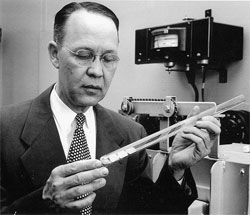
Bell Labs Demonstration
John Perlin explains the path from selenium to silicon. Let’s back up, the photo-electric effect was found quite by accident, in that the conductivity of selenium was determined to be affected by light. At the time, selenium bars were used to test transatlantic cables before submersion. At night they were effective, but their performance for this sensitive testing was “dismal” during day light hours.
Scientists determined that the bars were affected by conductivity, affected by sunlight. After some study, it was determined that light caused a flow of electricity through a solid material. The current produced was called “photoelectric.”
The first photoelectric module was built by Charles Fritts and mounted on his New York City rooftop in 1886. This was only four years after Thomas Edison powered up the nation’s first central power plant. The Pearl Street Station began to produce power in New York City in 1882, demonstrating Edison’s concept of complete service from generation to his new incandescent bulbs. Technologically distant from the Edison Illuminating Company’s coal-fired dynamo, Fritts spread a thin layer of selenium on a metal plate. He then covered it with a thin semi-transparent gold-leaf film. His module produced a current that was “continuous, constant, and of considerable force.”
Einstein’s discoveries of “light quanta” earned him the Nobel Prize in 1922. He’s been called the father of modern photovoltaics. Einstein postulated that light contains packets of energy, called light quanta, or photons. The amount of power varies; the shorter the wavelength the greater the power. Einstein provided photoelectricity with a scientific framework that it had previously lacked. By the late 1920s, scientists referred to this effect as the “photovoltaic” effect.
Bell Laboratories in Murray Hill, New Jersey developed the first practical solar cell. Its scientists, led by the likes of Calvin Fuller, Gerald Pearson, and Daryl Chapin, and heralded for their pioneering efforts to control the introduction of impurities into silicon to promote solar conductivity. Together they were able to transform silicon from a poor to a preeminent conductor of electricity. The research culminated in the discovery of an effective “p-n junction” in which the silicon semiconductor material is prepared on one side with trace amounts of gallium, and lithium on the other. Then “outside activation” of the semiconductor material comes in the form of sunlight which starts the flow of electrons.
Bell’s needs were for worldwide telecommunications, providing small amounts of power in remote locations and often in humid locations. In addition to costly batteries, Bell researched wind, thermoelectric generators, small steam engines, but for Bell solar seemed to make most sense. Thus in 1953, photovoltaic research there began in earnest. Their first tests of selenium solar cells resulted in an efficiency of 0.5%. The next test was based on silicon and proved an efficiency of 2.3%, nearly five times that of selenium. Selenium was dropped. Chapin later produced a silicon cell with 6% efficiency. Today, crystalline solar cells are generally 16 – 18% efficient. (Costly multi-junction cells have been tested as high as 44.7% efficient; cells developed for space missions are 28 – 29% efficient.)
But then, solar electricity was brand new to the public, at best a whimsical new way to generate. In 1954, a miniature, solar-powered Ferris wheel got the public’s attention. It only needed light on its small panel to run. Other simple devices, like fans on baseball caps powered by small solar cells, were intriguing and introduced solar cells to the public. Then a radio broadcast transmitted with solar power. Scientists suggested that this “may mark the beginning of a new era… harnessing the almost limitless energy of the sun for uses of civilization.”
But for all intents and purposes, until 1961 the solar cell was a curiosity item. Then the space program made it legitimate. NASA found that solar was the only reliable long-term power source in space. Perlin reports that solar was “saved by the space race.” Its use and research and development of solar were critical, powering satellites as early as 1958 and later the space station.
Niche PV Applications
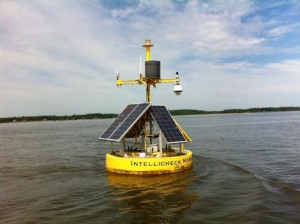
Solar Powered Buoy
Solar had proven to be reliable and durable but it was still really expensive. In 1965, a watt of solar cost $286. A $1.4 million solar system would be required to power an average house. Clearly, solar only made sense in niche applications where there was no better alternative.
During his presidency, Ronald Reagan praised the Coast Guard for money saved by installing solar cells to power maritime navigation that had been run using costly batteries. When oil rigs in Gulf of Mexico were required to install horns and lights to warn ships of their presence at night and in inclement weather, solar was found to be a cost-effective alternative to battery systems and became widespread.
Solar certainly makes sense for the developing world. One-third of humanity is still without electricity due to the prohibitive costs of electrification, the infrastructure needs for centralized power production. Over the years, diesel generators have been utilitarian but expensive to operate. In remote communities in developing countries, ad hoc solutions such as kerosene lamps, open fires for lighting, and batteries are unsustainable. There, small-scale solar offers important rays of light and hope.

Solar Lighting in Sénégal
Photovoltaics are now poised to power up the southern hemisphere one rooftop at a time. An early project for remote homes in French Tahiti was sponsored by French Atomic Energy Commission in 1978. Nuclear testing in Polynesia had not endeared the French to the locals, so it wanted “to be popular.” Hundreds of homes were provided with solar systems and batteries for lights and other essential needs, demonstrating a new power model for communities.
Rooftop solar burst into prominence in Switzerland in 1987 when Alpha Real – the car company – launched its Megawatt Project. It sought and signed up 333 power-station owners (homeowners) who sold excess power to the grid at 2 cents and received power in the evening for 6 cents. The project in Zurich was the largest demonstration of rooftop solar at the time.
The French Lighthouse service began replacing acetylene systems with electric lights powered with solar modules in 1981. By 1983 Greece had installed photovoltaics to power the lights on most of its 960 buoys and lighthouses. Solar has proved reliable, even when exposed to harsh elements such as storm seas.
The Modern Age of Photovoltaics
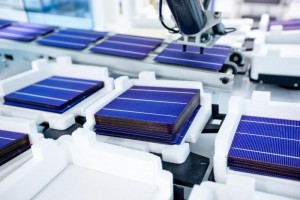
Modern Solar Cell Production
Crystalline silicone remains the dominant photovoltaic material, basically the same substance that was discovered at the Bell Laboratories in the 1950s. “It works, and it works for a very long time,” was a researcher’s finding then, and it holds true now. To this day, crystals are grown by melting silicon to 2,750 degree F in a rotating vat, and then drawing it up a crystal out of the melt using a puller spinning in the opposite direction. This produces a single crystalline cylinder 7 – 8 feet in height.
The solar revolution, from its infancy to at least its adolescence. Its growth rate has been profound. Solar farms are impressive but may be old school centralized solutions. The sun is inherently decentralized. Steve Strong presents the benefits of distributed generation, and embedding clean energy in our housing and built environment. He notes the values of avoiding land purchases, digging holes, pouring concrete, burying conduits, etc. Don Osborn, former SMUD solar director comments on traditional utility grids’ line losses. Solar on your roof avoids this penalty. Rooftops employ “free land.”
Despite these gains, the federal government has yet to take solar seriously. President Jimmy Carter’s meager solar budget was slashed by Ronald Reagan. This caused Japan to become the preeminent solar nation for a decade or so. By 2002, there were 400,000 homes with solar in Japan. At the time it was the world leader in grid-connected systems and in manufacturing of solar panels. Then while the United States stood by, Germany took the lead with its impressive feed-in tariff pricing in 2004. At the time of Perlin’s writing, there has been over 30 GW of solar installed in Germany compared to 4 GW in the entire United States.
Conclusion
Reading John’s book, and gaining so much from it, reminded me of a Dave Bill quote of some note. He was referring to Amory Lovins, and said reading his research papers was like “drinking from a fire hose.” In this case, John has assembled a volume of solar knowledge. Thanks John.
Let it Shine presents valuable perspectives… notably the length of time that mankind has been harnessing the sun, all the while envisioning how to do it better. This quest is long-term. Now our thirst and demand for sustainable energy solutions puts solar front and center.
“Practical” solar electric production is 60 years old. It’s come a long way, and certainly has a long way to go. It’s only just begun. We’ll soon see lots of semiconductor materials and their most creative applications. Reading John’s book made me feel like part of a continuum, the solar conveyor belt… refined all the while.
I’ve learned about a lot of solar pioneers. In 1886 Charles Fritts contested that his selenium solar panels would one day compete with Thomas Edison’s coal-fired power plants. An outlandish thought it was given the small efficiencies his systems gained. But my goodness, he is now right. Solar is at parity with coal and the grid, while far outstripping it in merit.
